For my birthday, my parents gave me a certificate to get PADI Advanced Open Water Diver certified with Dive St. Lucia. To get Advanced Open Water Diver certified you first need to complete the online, or in classroom, training and then pass the final exam. Next, you have to successfully complete five (5) “adventure dives,” two (2) of which are mandatory. The mandatory dives are “Deep Dive” and “Underwater Navigation.” For our optional dives, we chose “Wreck Diving,” “Peak Performance Buoyancy” and “Underwater Photography.” Throughout the course, my mom was my diving “buddy.” We dove twice a day, three days in row, to complete the 5 adventure dives, plus one bonus “fun dive.” Our very competent and knowledgeable instructor for the course was Wendy.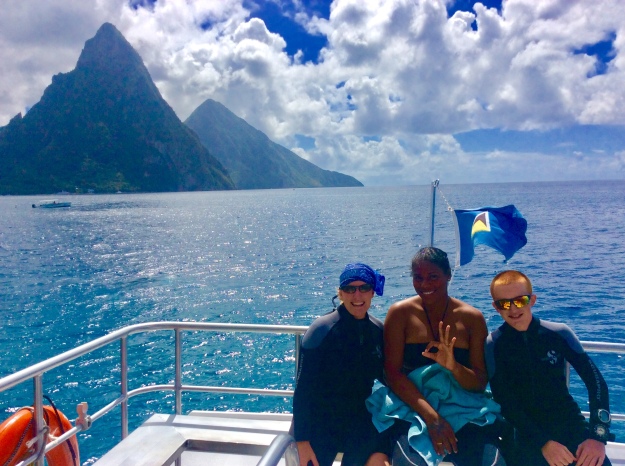 Theresa, Wendy (dive instructor) & Ryan in front of the Pitons, St. Lucia (Jan. 2018)
Theresa, Wendy (dive instructor) & Ryan in front of the Pitons, St. Lucia (Jan. 2018)
DAY ONE – DEEP DIVE & UNDERWATER NAVIGATION
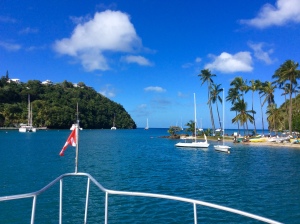
Marigot Bay, St. Lucia
We arrived at Dive St. Lucia at 8:15 a.m. and picked out and prepared the gear we would use for the course. At 9:00 a.m. the dive boat shoved off and headed south towards the Pitons. It took us about an hour to get down to Marigot Bay where we picked up more divers.
Wendy then went over the dive plan for our first dive and we geared up. The first dive site was called “Superman’s Flight,” because of the strong current, and was located below the St. Lucia’s famed Gros Piton.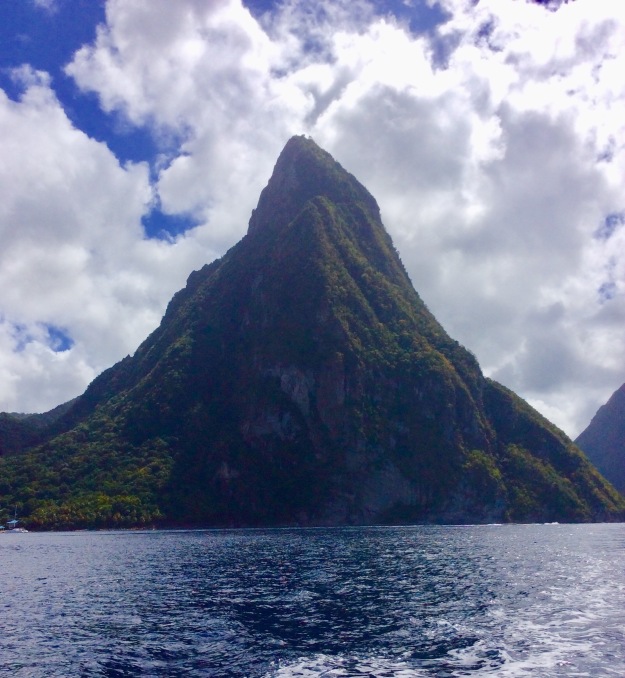
Gros Piton, St. Lucia
Superman’s Flight was our Deep Dive. For the Deep Dive, you have to dive down 60-100 feet below the surface. Since I was only twelve at the time, our deep dive was limited to only 70 feet (you have to be 14 to dive down to 100 feet). Our dive instructor brought an egg down with us and cracked it 70 feet below the surface to show us the effect that pressure has that deep. (Click photo below to see what happens to an egg when you crack it 70 feet under water.)
The yolk and the fluid surrounding it stayed in tact. It kind of resembled a ping pong ball. After ascending approximately 10 feet, to 60 feet, due to decreased pressure, the yolk started to fall apart. That was my science class for the day. Afterwards, we drifted along the colorful reef in a super man pose. As the current pulled us along we saw tons of cool coral and sea life. After 40 minutes, and a three minute safety stop at 15 feet, we concluded the dive. The dive boat came over and picked us up for lunch.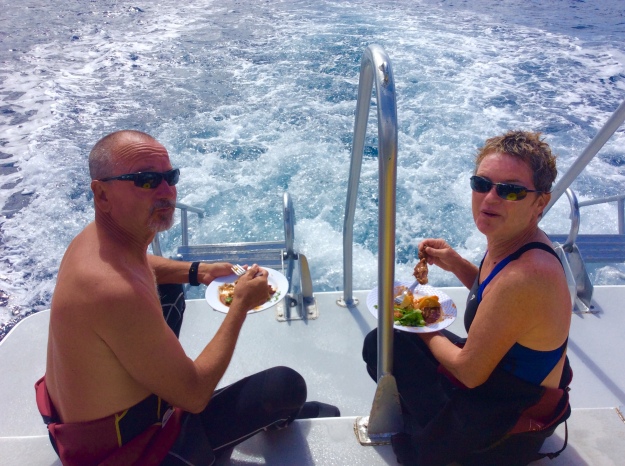 Friends, Captains Marty and Suzanne (M/V Alizann), enjoying lunch lunch between dives in St. Lucia (Jan. 2018)
Friends, Captains Marty and Suzanne (M/V Alizann), enjoying lunch lunch between dives in St. Lucia (Jan. 2018)
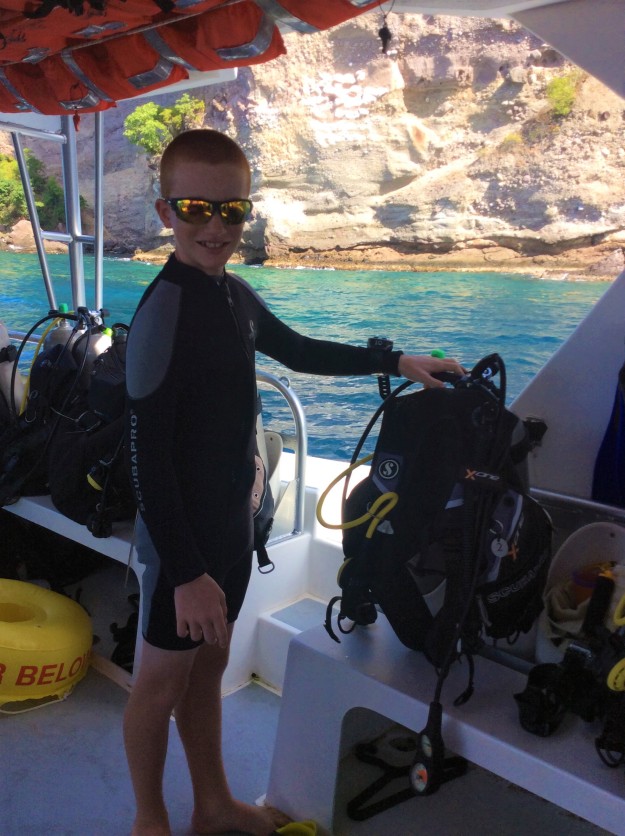
Ryan getting ready to dive in St. Lucia (Jan. 2018)
After lunch we traveled north to the next dive site “Fantasia.” On that dive we had to complete our mandatory Underwater Navigation skills. Wendy gave us compasses and briefed us on the drills we would be required to do under the water. After gearing up we took a giant stride into the water and descended. The first drill was measuring how many kick cycles it took Mom and I to go 100 feet (horizontally). Next we had to go 30 kick cycles on one compass heading then return to the same spot on the reciprocal heading. Once we both completed that we had to go 30 kick cycles in a different direction and use natural navigation to get back. Wendy told us not to use fish, crabs, etc. (or anything else that moves) as markers to help us navigate back.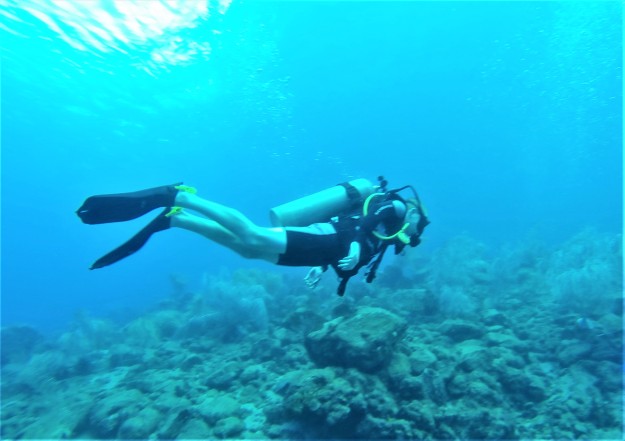
Ryan scuba diving in St. Lucia (Jan. 2018)Finally, we had to navigate a square. To navigate a square we had to go ten kick cycles in one direction, then, using our compasses, turn 90 degrees right. After two more 90 degree turns we ended up back where we initially started.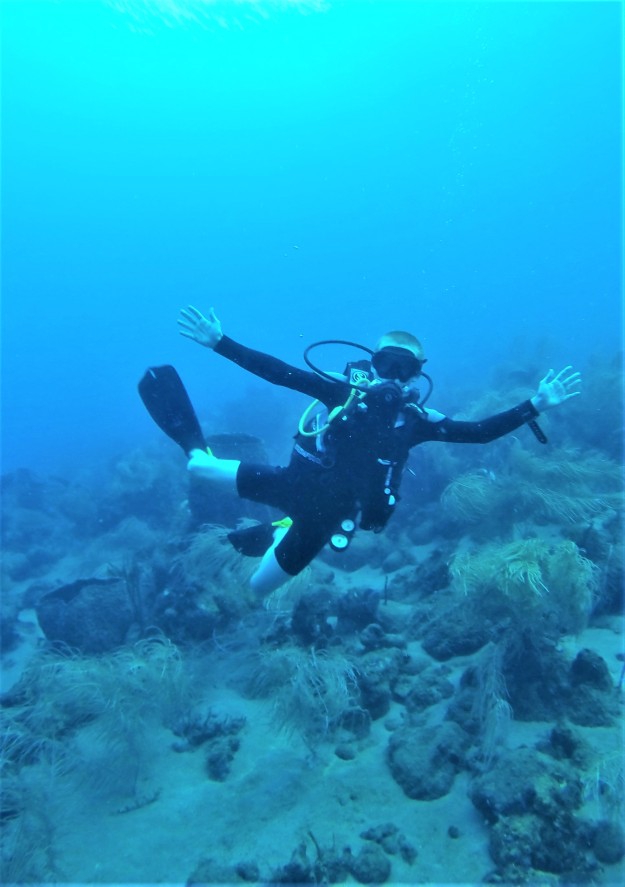 Ryan scuba diving in St. Lucia (Jan. 2018)
Ryan scuba diving in St. Lucia (Jan. 2018)
After completing all of the “hard work” we enjoyed diving the reef in Fantasia. Like most Caribbean dives, the dive was colorful and full of sea life.
DAY 2 – FUN DIVE & PEAK PERFORMANCE BUOYANCY (PBB)
Since we already had all our gear set up from the day before, on day 2 we arrived at Dive St. Lucia later than the day before. For our third dive, Dive St. Lucia Capt. Dwight escorted us to Turtle Reef and Anse Conchon South, down by the Pitons.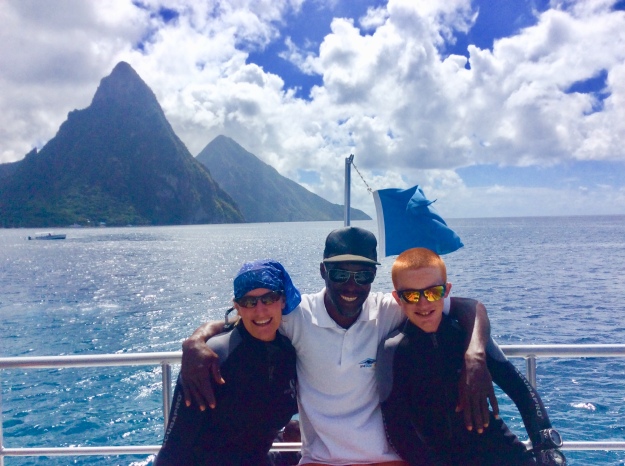 Theresa, Dive St. Lucia Capt. Dwight & Ryan (Jan. 2018)
Theresa, Dive St. Lucia Capt. Dwight & Ryan (Jan. 2018)
On the boat we learned that we would have another diver joining us for the day – Alfie – who was on vacation from England. 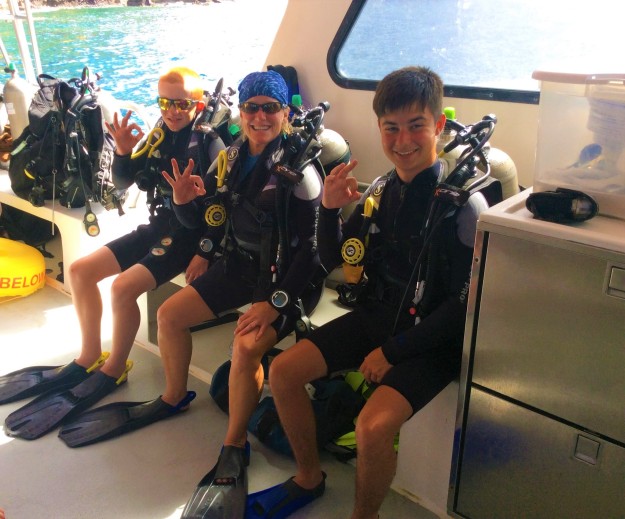 Ryan, Theresa & fellow diver Alfie getting ready to dive Turtle Reef in St. Lucia (Jan. 2018)
Ryan, Theresa & fellow diver Alfie getting ready to dive Turtle Reef in St. Lucia (Jan. 2018)
We picked up more divers and snorkelers in Marigot Bay, again, then continued heading South until we got to Turtle Reef. Our first dive was our fun dive so we did not have any skills to perform. We descended 60 feet and then started out over the reef. Strangely enough, that was the second time I went to Turtle Reef and did not see any turtles.
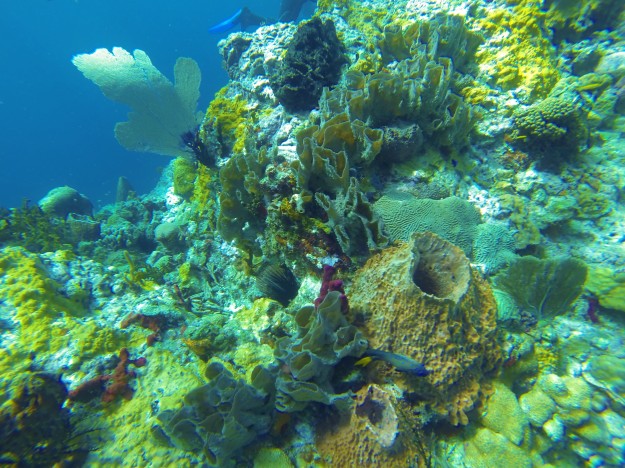
Turtle Reef in St. Lucia
I did see moray eels, fish and a lot of colorful coral. I just did not see a turtle. For now, I will just have to take it at the word of the person who named the reef that there are turtles there. Wendy pointed out all of the cool creatures we might have missed otherwise. Along a wall on the dive in a little crack I saw a huge lion fish, which was the biggest one any of us had ever seen. We also saw large crabs and even a octopus.
Like day one, the boat picked us up and we had a great lunch. We then traveled North to our second dive site “Anse Cochon South.” Our fourth dive was our Peak Performance Buoyancy or “PPB.” Some of our cruising friends said that PPB was the most beneficial of all the adventure dives because it teaches you how to best maintain neutral buoyancy. After completing the dive, I agree.
DAY 3 – WRECK DIVING & UNDERWATER PHOTOGRAPHY
Out of all three days, day three was probably the best. We started heading South from Rodney Bay around 9:00 a.m., and like every other day, we picked people up in Marigot Bay. Our first dive site was the Lesleen M. Wreck. The Lesleen M. was purposely sunk in 1985 to create an artificial reef. We descended 60 feet and started the dive at the bow of the wreck. On the wreck dive we brought the cameras we would be using for our underwater photography dive and got pictures and videos of the wreck. Inside the cracks and portholes of the wreck there was sealife and creatures like moray eels. We swam towards the stern (back) and saw the prop and rudder. There were sea spiders and lots of coral encrusting the wreck. After circling the entire wreck we ascended to the top deck (of the wreck) and swam above it. We could see the part of the wreck that was damaged by Hurricane Irma. Due to the damage we were not able to penetrate the wreck. We were underwater for 60 minute on our first dive before ascending to the surface. (Click photo below for video and photos of the Lesleen M wreck and Anse Conchon dives.)
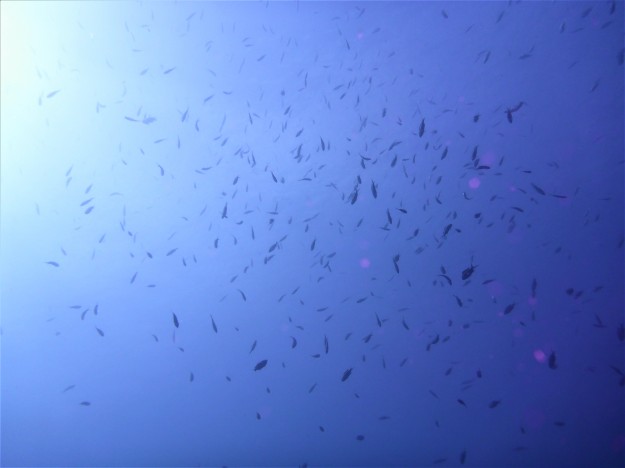 Lesleen M Wreck in St. Lucia (Jan. 2018)
Lesleen M Wreck in St. Lucia (Jan. 2018)
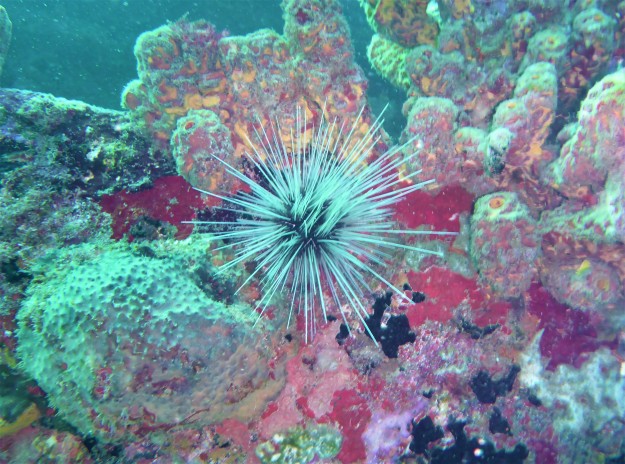
Lesleen M Wreck in St. Lucia (Jan. 2018)
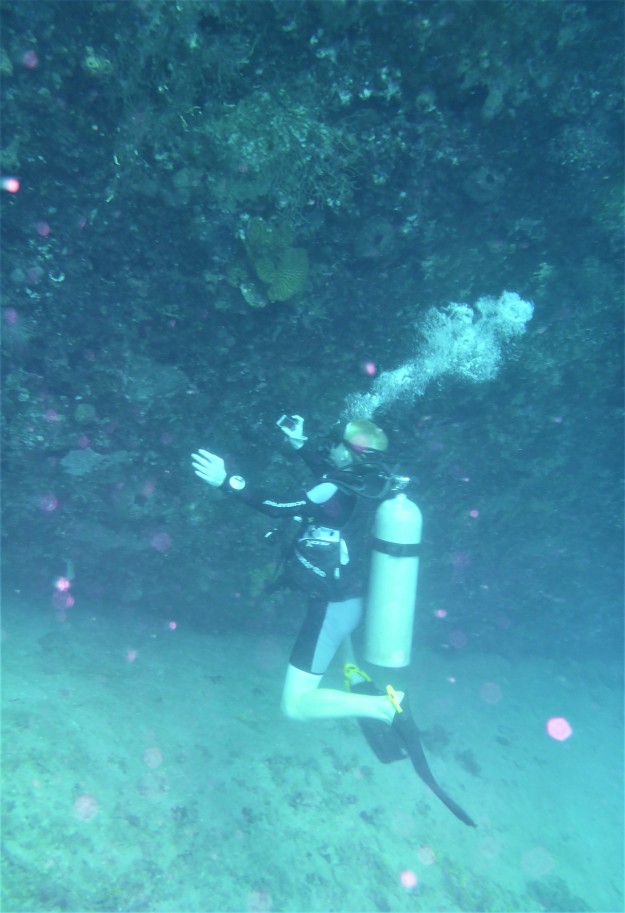
Ryan photographing the Lesleen M Wreck in St. Lucia – 65 feet below sea level (Jan. 2018)
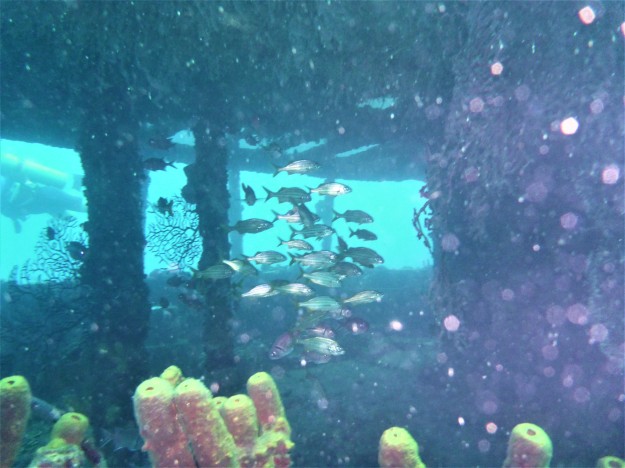
The bridge of the Lesleen M Wreck in St. Lucia (Jan. 2018)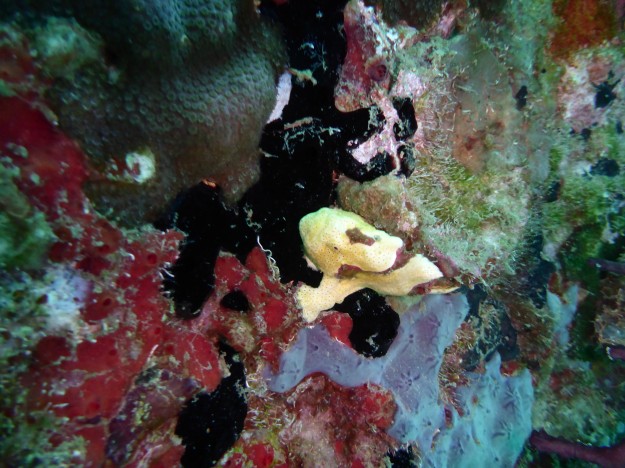 Lesleen M Wreck in St. Lucia (Jan. 2018)
Lesleen M Wreck in St. Lucia (Jan. 2018)
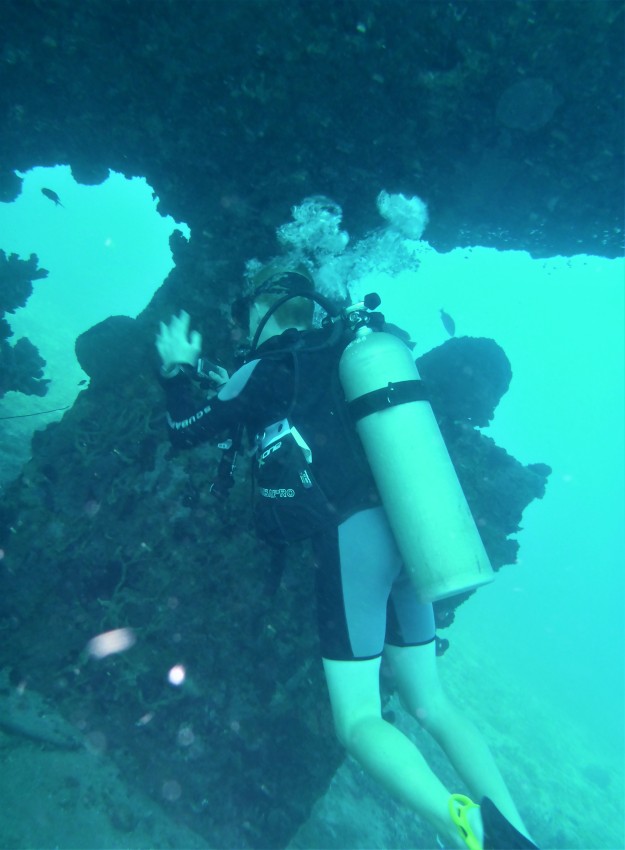
Ryan exploring the rudder of the Lesleen M Wreck in St. Lucia, 65 feet below sea level (Jan. 2018) Lesleen M Wreck in St. Lucia – 65 ft below sea level looking up (Jan. 2018)
Lesleen M Wreck in St. Lucia – 65 ft below sea level looking up (Jan. 2018)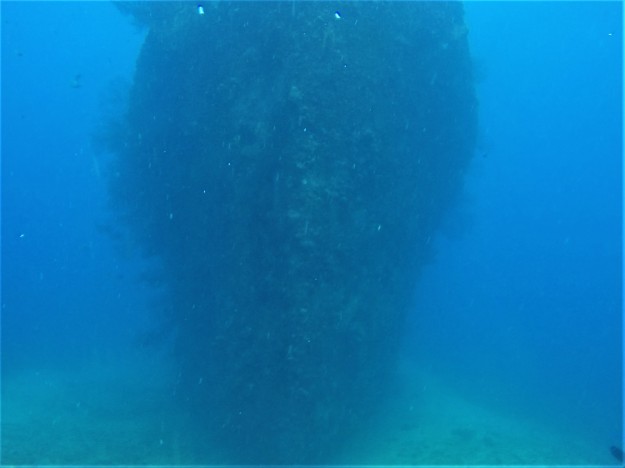 Lesleen M Wreck in St. Lucia – 65 ft below sea level – looking towards the bow (Jan. 2018)
Lesleen M Wreck in St. Lucia – 65 ft below sea level – looking towards the bow (Jan. 2018)
After lunch, the boat dropped us off at Anse Cochon South. The skill we practiced on our second dive of the day was underwater photography and videography. There was lots of cool sea life to take pictures of along the reef. While taking pictures on top of the reef, sometimes moray eels would go right underneath us. We used the neutral buoyancy skills that we learned in PPB to get up close and steady to our “subjects.” Photography was definitely one of my favorites (out of five the dives) because it memorialized and allowed us to share our dive experiences. After 45 minutes, and a 3 minute safety stop at 15 feet, we ascended as newly PADI advanced certified divers! The boat picked us up and we traveled back to the dive shop.

Sea Urchins & Tubular Coral, Anse Cochon North, St. Lucia (Jan. 2018)
Out of all the PADI specialty courses I would recommend the PPB as the most beneficial and Wreck/Photography as the most fun. I think the Advanced Open Water Diver certification course helped us a lot as divers and certainly expanded our horizons in the world of PADI.

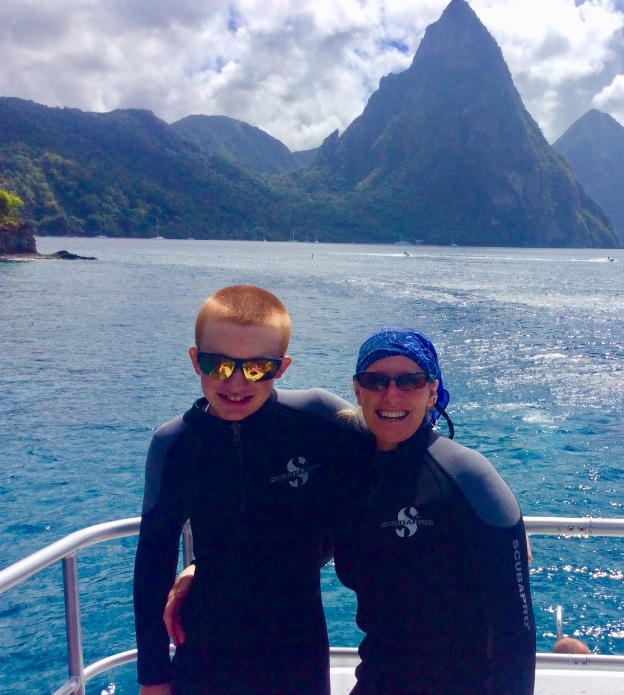
















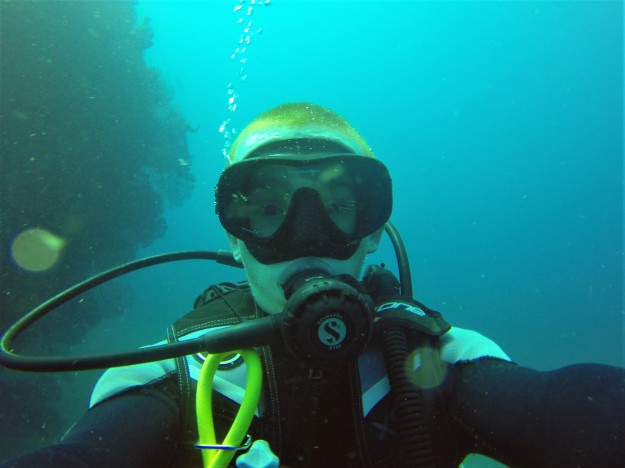
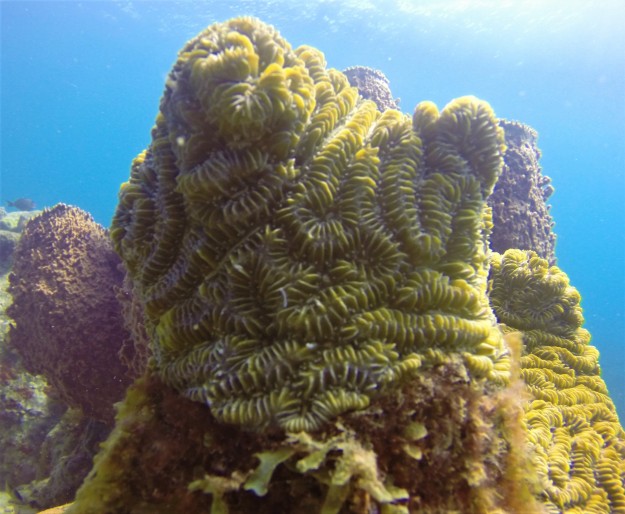




An excellent very informative article with great photos and videos. Thanks for sharing. And Happy Birthday!
LikeLike
Congratulations on receiving your certification. The story and pictures are amazing.
LikeLike
Congratulations to Ryan and Theresa for achieving the Advanced Open Water Scuba Certification. Upon reading your description, Ryan, I came to realize that what you have achieved is quite an accomplishment!
By the way, your written description is excellent! Your attention to detail, use of vocabulary and transitions from one dive to the next made the events come alive for me. Loved the photos and video as well. Your mom tells me that you used three different cameras to accomplish this.
Bravo on a job well done! Thank you for sharing this.
Love,
Aunt Patti
LikeLike
Hi Ryan,
Excellent description of the process you went through to receive your Advanced Open Water Scuba Certification! Congratulations on receiving your reward. The photos and video are outstanding. Bravo to a job well done.
Much love,
Aunt Patti
LikeLike